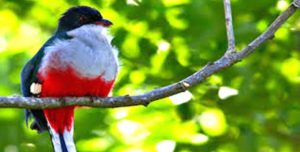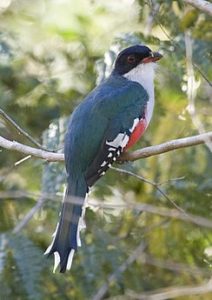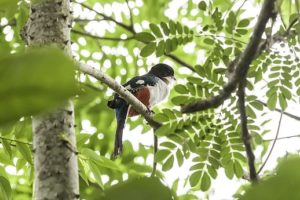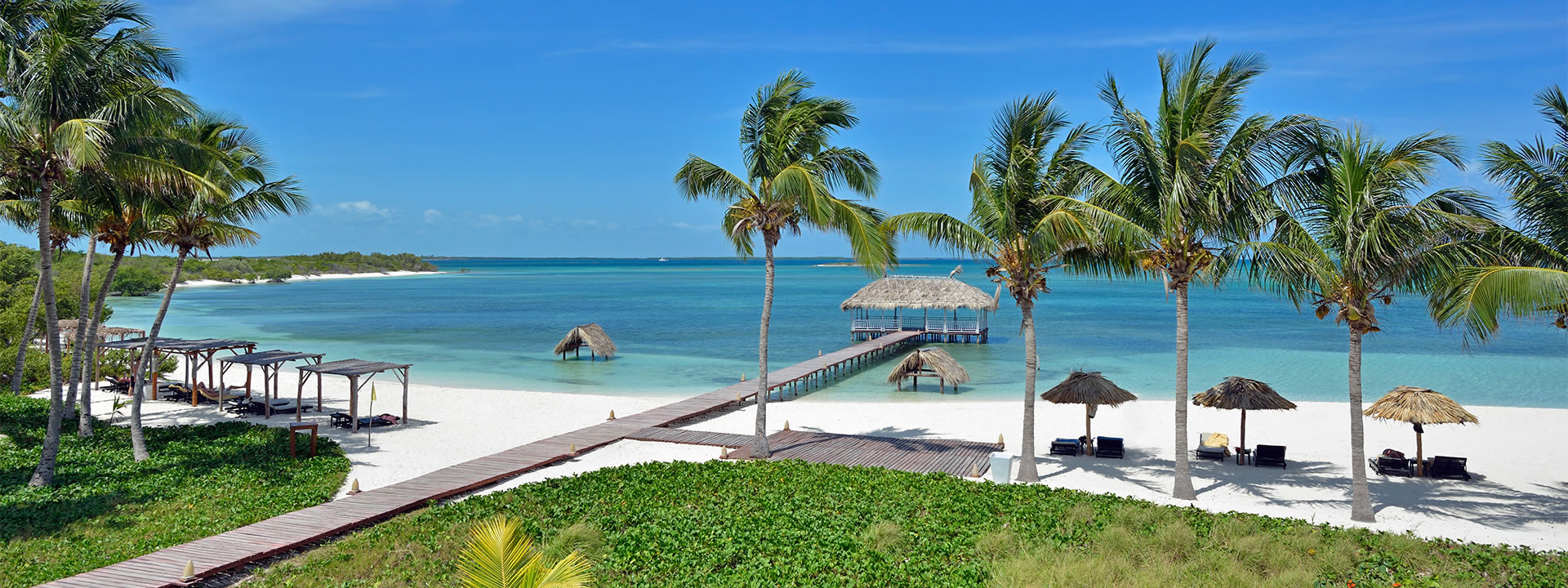 EL AVE NACIONAL DE CUBA: EL TOCORORO. VIDEOS.
EL AVE NACIONAL DE CUBA: EL TOCORORO. VIDEOS.
El tocororo cubano es una especie de ave de la familia Trogonidae. Es endémica de Cuba, donde también es el ave nacional. Sus hábitats naturales son bosques secos, bosques húmedos y bosques antiguos muy degradados.
El azul, el blanco y el rojo , colores de la bandera de Cuba, matizan el plumaje del tocororo, proclamado como el Ave Nacional de la República caribeña. Los aborígenes llamaban “ guatini” a esa especie endémica que alcanza 28 centímetros de longitud.
El tocororo cubano tiene múltiples nombres por los que puede pasar. En los países de habla inglesa se le conoce comúnmente como el trogón cubano, mientras que en los países de habla española se le conoce como tocororo o tocoloro. Este nombre local se deriva de su llamada repetida, toco-toco-tocoro-tocoro.
El tocororo cubano es muy colorido con un dorso verde, una corona azul, una barriga y un pico rojos, y una garganta y un pecho blancos. Estos colores imitan los colores de la bandera cubana, por lo que se eligió para ser el ave nacional de Cuba. Tiene una cola larga y esponjosa que es única entre los trogones. De pico a cola, esta ave mide entre diez y once pulgadas. En vuelo, estas aves viajan en parejas creando una gran cantidad de ruido debido a su técnica de vuelo rudo y sin gracia. Y cuando queda atrapado en una jaula muere.
La llamada más común del trogón cubano es toco-toco-tocoro-tocoro, del cual se deriva su nombre local. También hace una llamada de emergencia corta que es difícil de identificar.
Habitat
El trogón cubano es muy común y se puede encontrar en toda la isla de Cuba. Los únicos lugares en los que es raro ver a esta ave son en la Isla de la Juventud, Guajaba, Romano y Sabinal. Prefieren los bosques húmedos y secos de todas las altitudes y les gusta estar a la sombra en lugar del sol. El tocororo cubano anida en grietas ya creadas en árboles, principalmente en orificios de pájaros carpinteros abandonados. El tocororo cubano se alimenta de flores, frutas e insectos. A diferencia de la mayoría de las aves, es capaz de flotar mientras come.
El Tocororo Cubano al ser enjaulado, pierde su bello plumaje. En cautiverio, sobrevive poco tiempo.
Proclamado como el Ave Nacional de Cuba por su amor a la libertad y plumaje matizado por el rojo, el azul y el blanco, colores de la enseña patria, para los cubanos proteger el tocororo es defender nuestra identidad.
 THE NATIONAL BIRD OF CUBA: THE TOCORORO. VIDEOS.
THE NATIONAL BIRD OF CUBA: THE TOCORORO. VIDEOS.
The Cuban tocororo is a species of bird of the Trogonidae family. It is endemic to Cuba, where it is also the national bird. Its natural habitats are dry forests, humid forests and old degraded forests.
The blue, white and red, colors of the Cuban flag, nuance the plumage of the tocororo, proclaimed as the National Bird of the Caribbean Republic. The aborigines called “guatini” to that endemic species that reaches 28 centimeters in length.
The Cuban tocororo has multiple names by which it can happen. In English-speaking countries, it is commonly known as the Cuban trogon, while in Spanish-speaking countries it is known as tocororo or tocoloro. This local name is derived from its repeated call, toco-toco-tocoro-tocoro.
The Cuban tocororo is very colorful with a greenback, a blue crown, a red belly and a beak, and a white throat and chest. These colors imitate the colors of the Cuban flag, so it was chosen to be the national bird of Cuba. It has a long, fluffy tail that is unique among trogons. From beak to tail, this bird measures between ten and eleven inches. In flight, these birds travel in pairs creating a large amount of noise due to their flight technique rude and without grace. And when he is trapped in a cage he dies.
The most common call of the Cuban trogon is toco-toco-tocoro-tocoro, from which its local name is derived. It also makes a short emergency call that is difficult to identify.
Habitat
The Cuban Trogon (Tocororo) is very common and can be found throughout the island of Cuba. The only places where it is rare to see this bird are in the Isle of Youth, Guajaba, Romano and Sabinal. They prefer humid and dry forests of all altitudes and like to be in the shade instead of the sun. The Cuban tocororo nests in cracks already created in trees, mainly in holes of abandoned woodpeckers. The Cuban tocororo feeds on flowers, fruits, and insects. Unlike most birds, it is able to float while eating.
The Cuban Tocororo to be caged loses its beautiful plumage. In captivity, he survives a short time.
Proclaimed as the National Bird of Cuba for its love of freedom and plumage nuanced by red, blue and white, colors of the national flag, for Cubans to protect the tocororo is to defend our identity.
Agencies/RHC/ Teresita Martinez/ Maria Calvo/ Wiki/ Internet Photos/ YouTube/ Arnldo Varona/ www.TheCubanhistory.com
THE CUBAN HISTORY, HOLLYWOOD.



 < THE NATIONAL Bird of Cuba: "El Tocororo". VIDEOS.
< THE NATIONAL Bird of Cuba: "El Tocororo". VIDEOS.

